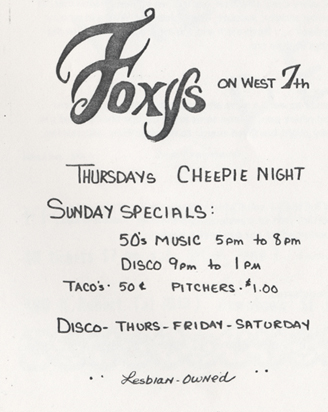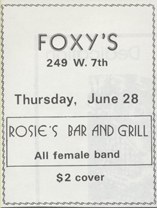Difference between revisions of "Foxy's Bar"
| Line 32: | Line 32: | ||
| − | + | Foxy’s opened in 1068,(*) and by all accounts, it did not discriminate against men. The lesbian nightclub accepted women and men from all backgrounds. However, and perhaps as a result of nearby industrial work sites that employed butch women, some prospective patrons were turned away by their own beliefs in negative rumors. These rumors identified Foxy’s as a place for “Bad Dykes,” or aggressive butch women. | |
| − | Foxy's closed at its Seventh Street location, and the Over the Rainbow Bar replaced it | + | Foxy's closed at its Seventh Street location in 1984, and the Over the Rainbow Bar replaced it. The bar's owners next opened the Castle Royal on [[The West Side Flats]] before Honey Harold reopened Foxy's in the former site of the [[Grand Finale]] in downtown St. Paul.(1) |
|} | |} | ||
| − | |||
| − | |||
| − | |||
| − | |||
| − | |||
---- | ---- | ||
(1) Douma, Greatchen. "New bars Expand St. Paul Nightlife" Equal Time, issue 90, 9/18/1985. | (1) Douma, Greatchen. "New bars Expand St. Paul Nightlife" Equal Time, issue 90, 9/18/1985. | ||
| + | |||
| + | (*) Klauda, Ann. "Foxy's to Close, Owners Open Castle Royal" Equal Time, issue 64, 9/19/1984 | ||
This page is still under construction. --SVC | This page is still under construction. --SVC | ||
Part of [[Minneapolis/St. Paul, MN: 100 Queer Places in Minnesota History, (1860-1969), (1969-2010)]] | Part of [[Minneapolis/St. Paul, MN: 100 Queer Places in Minnesota History, (1860-1969), (1969-2010)]] | ||
Revision as of 14:03, 18 March 2010
249 West Seventh Street, St. Paul
| Foxy's Ad from the 1979 Twin Cities Pride Guide. Courtesy of the Jean-Nickolaus Tretter Collection. |
Foxy’s Bar was a popular neighborhood bar and night spot for queer women who settled in the West Seventh Neighborhood of St. Paul. Women likely chose West Seventh--formerly a neighborhood of Eastern European immigrants--because it was the safest neighborhood for its price with easy access to downtown St. Paul’s jobs.
|
Once a socially acceptable location for women to live together, the large district stretched from the old seven corners area (roughly the site of the Xcel Energy Center), north to the Cathedral, towards the Minnesota State Capitol and Central Park, and east to Broadway Street. Sadly, postwar ideas regarding marriage and child rearing removed the social support for female households.
 Foxy's Ad from the 1978 "Lesbian" Twin Cities Pride Guide. Courtesy of the Jean-Nickolaus Tretter Collection. |
At the same time, plans for the State Capitol Grounds, MN, Interstate 94, and Interstate 35E demolished much of the old apartment district where female couples used to live. Without other affordable options close to their workplaces, determined women (or women with the luxury of choice) settled along West Seventh Street and established a separatist lesbian community.
|
(1) Douma, Greatchen. "New bars Expand St. Paul Nightlife" Equal Time, issue 90, 9/18/1985.
(*) Klauda, Ann. "Foxy's to Close, Owners Open Castle Royal" Equal Time, issue 64, 9/19/1984
This page is still under construction. --SVC
Part of Minneapolis/St. Paul, MN: 100 Queer Places in Minnesota History, (1860-1969), (1969-2010)
